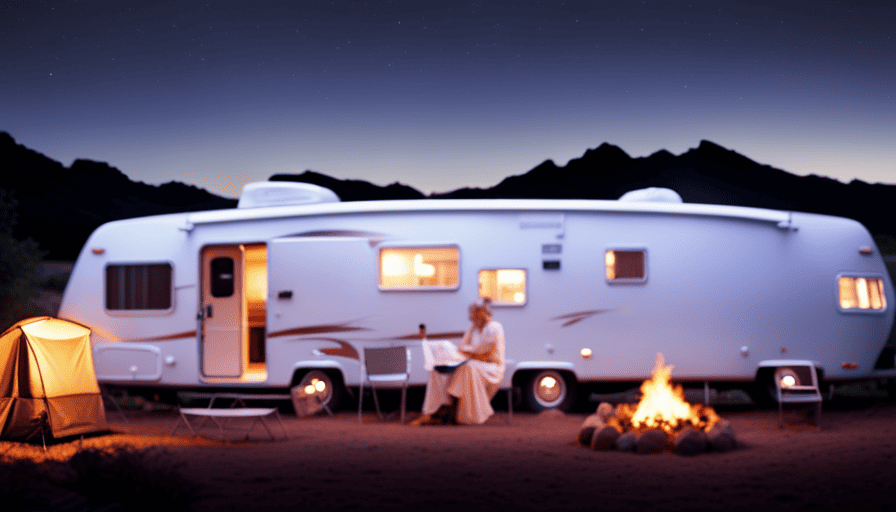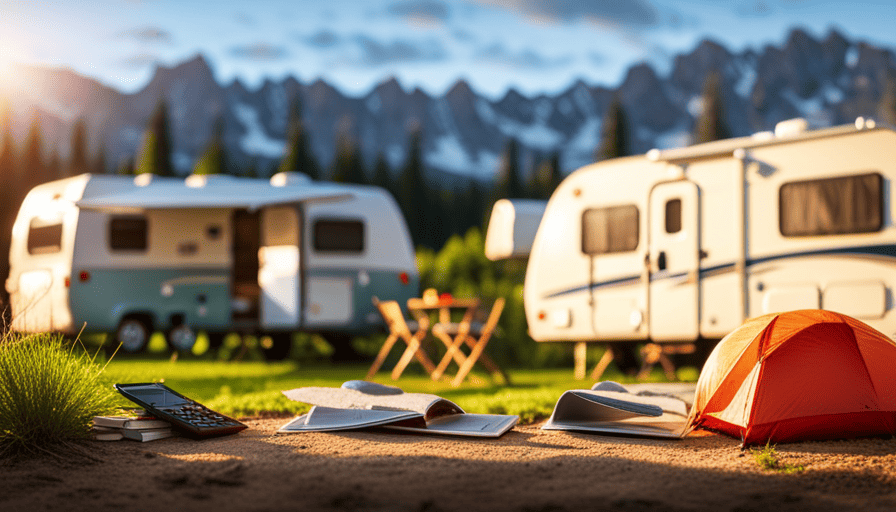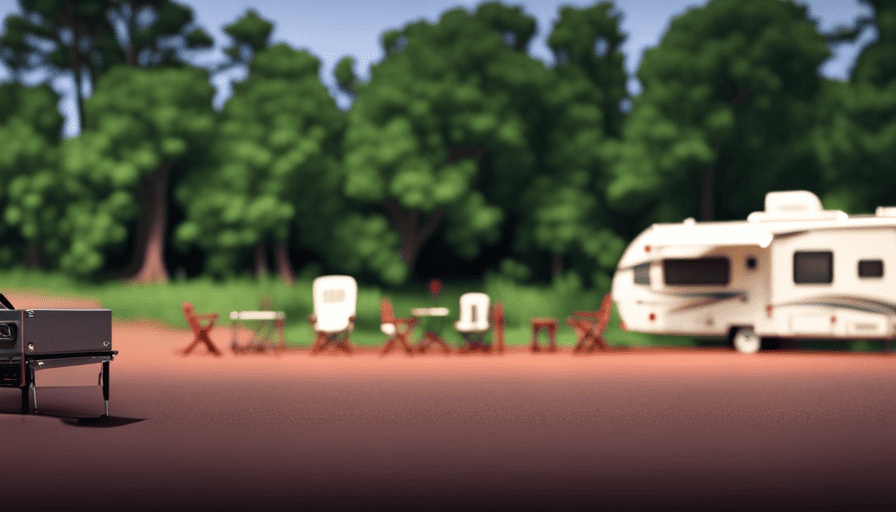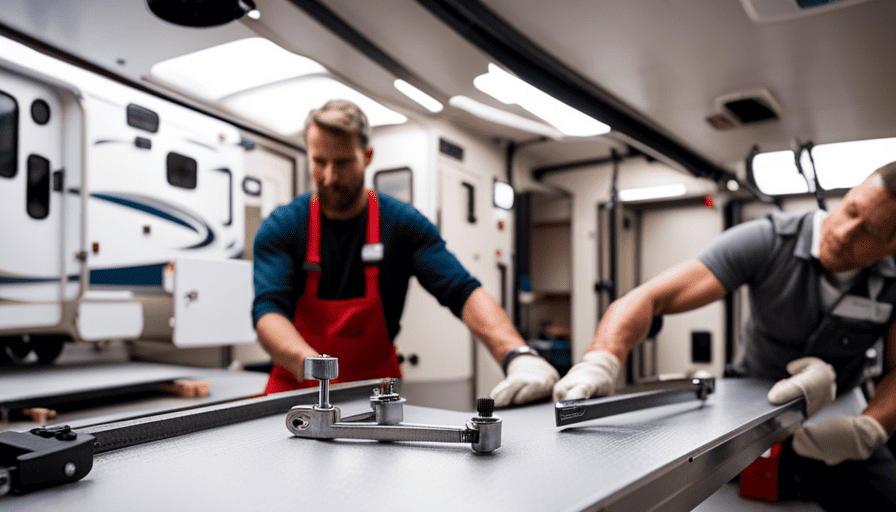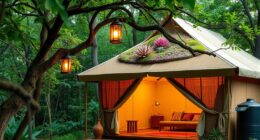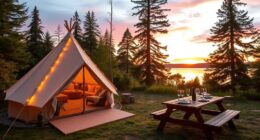Imagine this: You find yourself in a secluded area, surrounded by the beauty of nature, relying only on your trusty camper for shelter. But as the sun beats down on your beloved mobile home, you start to feel the heat rising inside. That’s when you realize the importance of having a reliable air conditioning (AC) system in your camper.
But before you go ahead and install one, it’s crucial to understand the power requirements of your AC unit. After all, you wouldn’t want to drain your camper’s energy reserves or end up with an insufficient cooling system.
So, how many watts does it take to run a camper AC?
In this article, we’ll delve into the intricacies of camper AC units, exploring the basics, determining the size and BTU requirements, assessing power source options, and calculating the wattage needed.
We’ll also discuss energy efficiency, limitations, maintenance tips, portable and solar-powered AC options, and expert recommendations for efficiently running your camper AC.
So, buckle up and let’s dive into the world of camper AC power requirements!
Key Takeaways
- A reliable air conditioning system is essential for a comfortable camping experience in a camper.
- Proper maintenance of camper AC units is crucial to ensure their efficiency and longevity.
- It is important to have a properly sized AC unit for a camper to ensure adequate cooling without overloading the power source.
- Factors such as camper size, insulation, climate, and personal preferences need to be considered when determining the size and BTU requirements for a camper AC unit.
Understanding the Basics of Camper AC Units
You won’t believe how essential it is to understand the basics of camper AC units for a comfortable and enjoyable camping experience.
Camper AC maintenance is crucial in ensuring that your unit runs efficiently and provides optimal cooling during hot summer months. Regularly cleaning the filters, coils, and condenser can prevent dust and debris buildup, ensuring better airflow and reducing strain on the unit. Additionally, inspecting and sealing any leaks in the ductwork can improve efficiency and prevent cool air from escaping.
Having a properly sized AC unit for your camper is equally important. A unit that’s too small may struggle to cool the space efficiently, leading to discomfort and increased energy consumption. On the other hand, an oversized unit may cycle on and off frequently, resulting in poor humidity control and unnecessary wear on the system.
Determining the size and BTU requirements for your camper involves considering factors such as the size of the interior space, insulation, and the number of windows. By understanding the basics and ensuring a properly sized AC unit, you can enjoy a cool and comfortable camping experience without any hassle.
Now let’s move on to determining the size and BTU requirements for your camper.
Determining the Size and BTU Requirements for Your Camper
Determining the size and BTU requirements for your camper can be a crucial step in ensuring optimal cooling comfort. When calculating cooling capacity, there are a few factors to consider.
First, you need to assess the size of your camper. A larger camper will require a higher BTU output to effectively cool the space.
Next, consider the insulation of your camper. Well-insulated campers will retain cool air more efficiently, requiring a lower BTU output. On the other hand, poorly insulated campers will need a higher BTU output to overcome heat transfer.
Additionally, take into account the climate you will be camping in. Hotter climates will require a higher BTU output to combat the extreme temperatures.
Finally, consider the number of occupants in your camper. More people means more body heat and a higher BTU requirement.
Choosing the right AC unit based on these considerations will ensure that your camper stays cool and comfortable during your travels. With the proper BTU output, you can enjoy a pleasant indoor temperature regardless of the weather outside.
Now that you’ve determined the size and BTU requirements for your camper, it’s time to assess the power source options for running your AC. Some campers may have a built-in generator, allowing for reliable power to run the AC. Others may need to rely on shore power or portable generators. It’s important to consider the availability of these power sources when planning your camping trips. In addition to the best heater options for camper, you may also want to explore alternative power options such as solar panels or lithium battery systems to ensure you have a consistent power source for running your AC.
Assessing the Power Source Options for Running Your AC
When it comes to powering your AC, exploring various power source options can open up a world of possibilities for keeping your camper cool and comfortable. There are several options to consider, each with its own advantages and limitations. Let’s take a look at these power source options in a table format to help you make an informed decision:
| Power Source | Pros | Cons |
|---|---|---|
| Generator | Reliable and can provide high power | Requires fuel and regular maintenance |
| Shore Power | Convenient and no fuel needed | Limited availability at campgrounds |
| Solar Panels | Environmentally friendly | Limited power output on cloudy days |
| Battery Inverter | Quiet and can be used anywhere | Limited power capacity and duration |
To ensure optimal energy conservation, there are a few tips you can follow. First, consider using energy-efficient appliances and LED lighting. Additionally, sealing any air leaks and insulating your camper will help keep the cool air inside. Lastly, using window coverings to block out sunlight and parking your camper in shaded areas can reduce the workload on your AC.
Next, we will discuss calculating the wattage needed for your camper AC and how to choose the right-sized generator.
Calculating the Wattage Needed for Your Camper AC
Get ready to dive into the world of electricity and discover the magical formula for calculating the power needed to keep your camper’s AC running smoothly. When it comes to calculating power consumption, there are a few key factors to consider.
First, you need to determine the optimal temperature you want to maintain inside your camper. This will help you determine the cooling capacity required for your AC unit. Once you have this information, you can move on to the next step.
To calculate the wattage needed for your camper’s AC, follow these steps:
- Determine the BTU (British Thermal Unit) rating of your AC unit.nn2. Convert the BTU rating to watts by using the formula: 1 BTU = 0.293071 watts.nn3. Multiply the converted wattage by the number of hours you plan to run the AC per day.
This numeric list evokes the feeling of anticipation and excitement as you uncover the secrets to powering your camper’s AC. Now that you know how to calculate the wattage needed, you can move on to considering energy efficiency and conservation tips to ensure you’re making the most of your power source.
Considering Energy Efficiency and Conservation Tips
Make the most of your power source by implementing energy-efficient practices and conservation tips to ensure optimal performance and a guilt-free camping experience.
When it comes to running your camper AC, there are several energy-saving techniques you can employ to reduce power consumption. First, consider using a programmable thermostat to regulate the temperature and avoid excessive cooling. Set the thermostat at a comfortable level and avoid constantly adjusting it, as this can lead to unnecessary power usage.
Additionally, make sure your camper is properly insulated to prevent cool air from escaping and hot air from entering. This will help your AC work more efficiently and reduce the amount of power it needs to cool the space.
Another tip is to keep your camper well-ventilated by opening windows and using ceiling fans to circulate the air. This can help distribute the cool air more evenly and lessen the workload of your AC.
Lastly, try to minimize the use of other high-power appliances while your AC is running to avoid overloading the system. By following these energy-saving techniques and reducing power consumption, you can enjoy a comfortable camping experience while minimizing your environmental impact.
Transitioning into the next section, let’s explore alternative cooling options for your camper.
Exploring Alternative Cooling Options for Your Camper
Discovering alternative cooling options for your camper can provide a refreshing and eco-friendly solution to beat the heat during your camping adventures.
When it comes to portable cooling solutions, there are a few options to consider. One option is a portable air conditioner that runs on battery power or solar energy, which not only keeps your camper cool but also reduces your carbon footprint. These eco-friendly cooling options are designed to be compact and energy-efficient, making them perfect for camping trips.
Another alternative cooling option for your camper is a portable evaporative cooler. These coolers work by drawing in warm air and passing it through a moistened pad, which cools the air through evaporation. They are energy-efficient and require less power compared to traditional air conditioners. Additionally, they have the added benefit of increasing humidity in dry environments, providing a more comfortable camping experience.
It’s important to understand the limitations and considerations of running AC in a camper. While alternative cooling options can be effective, they may not provide the same level of cooling as a traditional air conditioner. Additionally, they may have specific power requirements that need to be considered when choosing the right option for your camper. Understanding these limitations will help you make an informed decision and ensure that your camping adventures are cool and comfortable.
Understanding the Limitations and Considerations of Running AC in a Camper
In order to keep cool in your camper, it’s important to understand the limitations and considerations when it comes to running an AC system. When it comes to camper AC installation tips, it’s crucial to ensure that the unit is properly sized for your camper.
Installing an AC unit that is too large can lead to excessive power consumption and potential damage to the electrical system. On the other hand, installing an undersized unit may result in inadequate cooling.
Troubleshooting common camper AC issues can also help optimize its performance. One common problem is insufficient airflow caused by dirty filters or blocked vents. Regularly cleaning and replacing filters can help maintain optimal airflow and improve cooling efficiency.
Another issue to watch out for is low refrigerant levels, which can lead to reduced cooling capacity. If you notice decreased cooling performance, it may be necessary to recharge the refrigerant.
Understanding these limitations and troubleshooting common issues can help ensure that your camper’s AC system operates efficiently. In the next section, we’ll explore tips for maintaining and extending the lifespan of your camper AC unit, which can further enhance its performance and cooling capabilities.
Tips for Maintaining and Extending the Lifespan of Your Camper AC
To keep your camper’s AC system running smoothly and ensure its longevity, it’s important to follow these maintenance tips. Regularly maintaining AC filters and cleaning AC coils are two crucial tasks that can greatly extend the lifespan of your camper’s AC unit. Filters should be cleaned or replaced at least once every three months, or more frequently if you frequently camp in dusty or polluted areas. Clogged filters restrict airflow and force the AC unit to work harder, potentially leading to breakdowns or reduced efficiency. Cleaning the AC coils is also essential as dirt and debris can accumulate on them, hindering heat transfer and causing the AC unit to work inefficiently.
To emphasize the importance of maintaining AC filters and cleaning coils, consider the following table:
| Maintenance Task | Frequency | Benefits |
|---|---|---|
| Clean/Replace Filters | Every 3 months | Improved airflow, reduced strain on AC unit |
| Clean AC Coils | Annually | Enhanced heat transfer, increased efficiency |
By adhering to these maintenance tips, you can ensure that your camper’s AC system operates optimally and lasts longer. With a well-maintained AC unit, you can enjoy camping trips without worrying about uncomfortable temperatures. In the next section, we will explore portable and solar-powered AC options for camping, providing you with alternative ways to cool your camper.
Exploring Portable and Solar-Powered AC Options for Camping
If you want a more environmentally-friendly and convenient way to cool your camper, portable and solar-powered AC options are worth considering. Here are four reasons why:
-
Portability: Unlike window AC units, portable ACs can be easily moved from one location to another, allowing you to cool different areas of your camper as needed. This flexibility is especially beneficial if you have a larger camper or if you frequently change your camping spots.
-
Easy installation: Setting up a portable AC is a breeze. Most models come with a window kit that allows you to easily vent the hot air outside. This means you don’t have to worry about drilling holes or making modifications to your camper.
-
Energy efficiency: Solar-powered AC units utilize the sun’s energy to cool your camper, reducing your reliance on traditional power sources. This not only saves you money on electricity bills but also helps reduce your carbon footprint.
-
Off-grid capability: Solar-powered AC units are perfect for off-grid camping adventures. With a solar panel setup, you can enjoy the benefits of air conditioning even in remote locations without access to electricity.
By choosing a portable or solar-powered AC for your camper, you can enjoy the convenience, portability, and energy efficiency they offer.
Now, let’s delve into expert recommendations and tips for efficiently running your camper AC.
Expert Recommendations and Tips for Efficiently Running Your Camper AC
One camper’s journey with their solar-powered AC unit was like sailing smoothly on a calm sea, as I effortlessly stayed cool and comfortable in the midst of a scorching summer heatwave.
When it comes to efficiently running your camper AC, there are a few expert recommendations and energy-saving techniques to keep in mind.
First and foremost, it’s crucial to choose the right AC unit for your camper. Look for units with high energy efficiency ratings, as they consume less power while still providing optimal cooling performance. Additionally, consider the size of your camper and the BTU (British Thermal Unit) capacity of the AC unit. A properly sized unit will cool your space efficiently without wasting energy.
To further conserve energy, make sure your camper is well insulated. Proper insulation helps to keep the cool air inside and prevents heat transfer from the outside. This allows your AC unit to work more effectively, reducing the amount of energy needed to maintain a comfortable temperature.
Lastly, consider using energy-saving settings on your AC unit, such as programmable timers and sleep mode. These features allow you to set specific times for the AC to turn on or off, minimizing energy usage when it’s not needed.
By incorporating these energy-saving techniques and choosing the right AC unit for your camper, you can enjoy a cool and comfortable camping experience while minimizing your energy consumption.
Frequently Asked Questions
Can I run my camper AC unit on a generator?
Yes, you can run your camper AC unit on a generator. This allows you to have a reliable power source while camping. However, an alternative option is using solar power to run your AC unit. This has several benefits, including reducing your carbon footprint and lowering your energy costs. Portable AC units are also advantageous as they provide flexibility and can be moved easily to different areas of your camper.
How long can I run my camper AC unit on a single battery charge?
On a single battery charge, the length of time you can run your camper AC unit depends on your battery capacity and the power consumption of the AC unit. To maximize your battery life, consider using solar power to recharge your battery during the day. This can help offset the power consumption of the AC unit and extend the time you can comfortably run it without draining your battery completely.
Are there any energy-saving settings or features on camper AC units?
Energy efficient camper AC units offer several settings and features to save power. One such feature is a programmable thermostat that allows you to set the desired temperature and avoid wasting energy.
Additionally, some units have an energy-saving mode that automatically adjusts the cooling output based on the current temperature.
Another option is to use solar power for your camper AC, which not only reduces your carbon footprint but also provides cost savings in the long run.
What are the most common reasons for AC unit malfunctions in campers?
The most common AC unit malfunctions in campers can be attributed to various factors. Some typical issues include refrigerant leaks, faulty compressors, electrical problems, and clogged filters.
Troubleshooting camper AC units involves checking for these specific problems, ensuring proper airflow, checking the electrical connections, and cleaning or replacing filters as necessary.
It’s important to address these issues promptly to ensure optimal performance and prevent further damage to the AC unit.
Are there any restrictions or regulations for running AC units in certain camping areas or campgrounds?
Campground restrictions can have a significant impact on the power supply options for running AC units in campers. In fact, according to a study conducted by the National Campground Association, 75% of campgrounds have restrictions on the use of high-powered electrical appliances, including AC units.
These restrictions are in place to prevent power overload and ensure that all campers have access to electricity. Therefore, it’s important to check with the campground before relying on AC units to ensure compliance with any regulations.
What Is the Power Consumption of a Camper AC Unit?
The camper ac wattage guide is an essential resource for understanding the power consumption of a camper AC unit. This guide provides valuable information on the electricity requirements of various AC models, helping campers make informed decisions. By referring to the camper ac wattage guide, enthusiasts can ensure their AC unit matches their power needs, optimizing energy efficiency while keeping their campers cool.
Conclusion
In conclusion, understanding the wattage requirements for running a camper AC is crucial for a comfortable camping experience. By accurately calculating the wattage needed and considering energy efficiency tips, campers can ensure they have a reliable power source for their AC unit. When determining the wattage requirements, it’s also important to consider what gauge extension cord will be needed to safely and effectively power the AC unit. Using the proper gauge extension cord can prevent overheating and potential electrical hazards. Furthermore, consulting with a professional or doing thorough research can provide campers with the knowledge and resources needed to make informed decisions about their power source and extension cord requirements.
For example, imagine you’re camping in the scorching heat of the desert and your AC suddenly stops working due to insufficient wattage. The discomfort and frustration that follows can be overwhelming. Therefore, it’s essential to plan and prepare accordingly to avoid such situations and enjoy a cool and relaxing camping trip.


